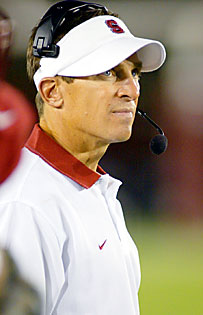 |
|
Courtesy Stanford Media Relations
|
Stanford head coach Buddy Teevens has had anything but a smooth transition in his first year as the head man at Stanford.
|
|
By Connor Doyle
Arizona Daily Wildcat
Thursday October 17, 2002
On the surface, it doesn't appear that the head coaches of Stanford and Arizona ÷ Buddy Teevens and John Mackovic, respectively ÷ have much in common, nor do their programs.
But Stanford's situation this season bears a strong resemblance to that of Arizona last year.
Teevens, much like Mackovic last season, is in the midst of changing the way the Cardinal (1-4, 0-3 Pac-10) play ball, especially on offense. Much like Mackovic began doing with the Arizona offense last season, Teevens has brought with him the desire to open up the passing game to resemble the "fun and gun" offense that he headed under Steve Spurrier at Florida.
The results for Teevens, much like they were for Mackovic, have been mixed.
What a difference a year makes
|
|
Last season
|
This season
|
|
Record
|
9-3 overall, 6-2 Pac-1
|
1-4 overall, 0-3 Pac-10
|
|
Rank |
No. 16
|
unranked
|
|
Offense
|
1st in Pac-10
|
9th in Pac-10
|
|
Defense
|
6th in Pac-10
|
Last in Pac-10
|
|
TO margin
|
4th in Pac-10
|
Last in Pac-10
|
|
Stanford, which led the Pac-10 in both total offense and scoring last season with averages of 451.5 yards and 37.1 points per game, has seen a major downturn in offensive production. This season, the Cardinal rank dead last in total offense with 372 yards per game, and second-to-last in scoring with 26.4 points per game.
But to say that Teevens has been a failure so far would be to ignore the enormity of the task before him. Wholesale changes always take time to catch, especially on offense. Not that it makes Teevens comfortable with his team's play so far this season.
"We've struggled a bit. We've played some decent teams, and we haven't played them particularly well," Teevens said. "Our passing game continues to struggle. We're working hard this week trying to rectify that situation."
That struggle has led to some shuffling issues between the two top quarterbacks on the team, senior Chris Lewis and freshman Kyle Matter. Lewis came into the season as the starter, but after missing the first game to suspension, has not had an easy time adjusting to the new scheme. Coming into the Arizona game, Lewis has completed fewer than 50 percent of his passes on the season (48.2 percent) and has thrown nine interceptions against only three touchdowns.
In turn, Matter has played an unexpectedly prominent role in the offense. In his first career start he looked solid against Boston College, throwing for 244 yards and a touchdown. Matter's stats have been better than Lewis', but Teevens has been hesitant to turn his back on the senior.
"I think (the new system is) like a foreign language," Teevens said. "It's a comfort level, and any individual that's been in the old system for a while will have greater difficulty adapting than someone who's new to it. I think in Chris' ÷ and Kyle's ÷ case, that's what we're seeing."
Teevens said Lewis' first priority this Saturday will be to exhibit better ball control, as Stanford has posted a ö7 turnover margin so far this season.
"We've had far too many turnovers. That's been the main area of inconsistency ÷ we keep giving it away. Last week, a couple of interceptions created scoring opportunities for Washington State," Teevens said. "It's just good decision-making and ball security from the quarterback standpoint, is what we're stressing."
This weekend will go a long way in being able to tell if Teevens' stressing has paid off. Arizona's secondary has been all but annihilated with injuries this season and this game could provide Lewis an opportunity to get into a rhythm. But if Lewis and the passing game continue to struggle, things will likely only get worse as the Pac-10 season rolls on.

